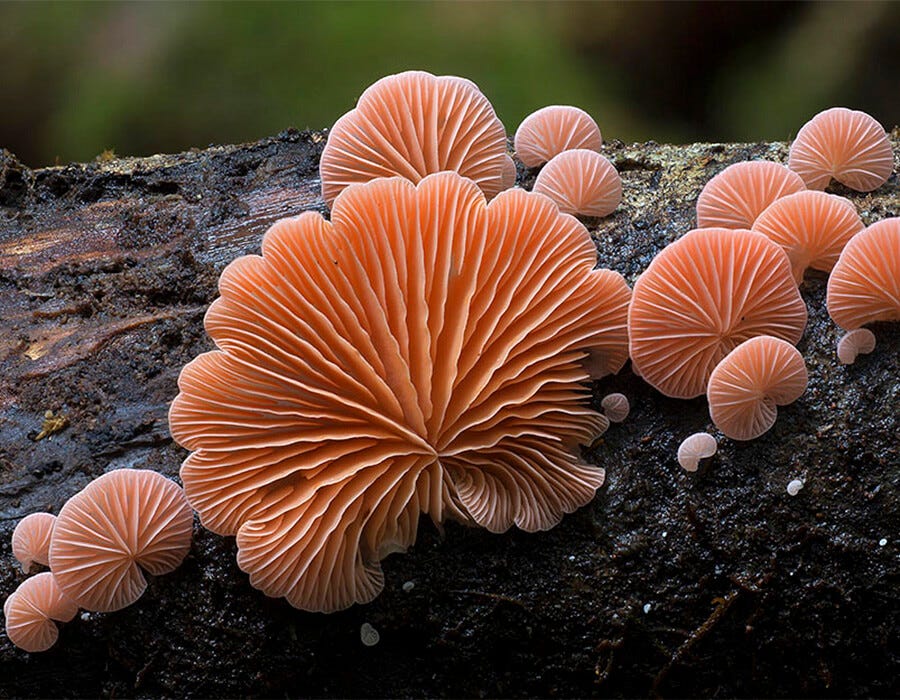Fungi
With bacteria, they are important decomposers, as they feed on organic substances from dead leaves, corpses and waste, contributing to the recycling of matter.
Although many species of fungi are parasites of plants and animals, others maintain ecological relationships of the mutualism type, that is, relationships in which there is an exchange of benefits between different species.
General features
Fungi are eukaryotes and, although there are unicellular forms, such as yeast, most are formed by a tangle of filaments, the hyphae, whose set is called mycelium.
The cell wall is formed by chitin, a nitrogenous polysaccharide that also appears in the skeleton of arthropods; in some cases, there is also cellulose.
Some fungi also have reproductive structures, the fruiting or fruiting bodies, which correspond to the visible part above the ground, called the mushroom.
Nutrition and breathing
Nutrition is heterotrophic by absorbing simple organic molecules, which may come from extracorporeal digestion carried out by the fungus itself: it releases digestive enzymes into the environment that break down complex organic molecules and absorb smaller molecules. In this process, many fungi act as decomposers, absorbing the organic molecules of dead organisms, acting as saprobes or saprophages. Others, however, are parasites, installing themselves in the body of other living beings and taking their food from it.
There are still fungi that obtain food through a mutualistic relationship and those that are predators, capturing small living beings.
Reproduction and dispersion
Asexual reproduction can be done by budding, in unicellular forms, by fragmentation of the mycelium or by the production of spores.
Sexual reproduction often results from the fusion of two haploid hyphae (n). The cytoplasm and nuclei fuse to form diploid (2n) hyphae, which divide by meiosis and form spores.
Classification
- Zygomycetes: generally live in the soil. Some are used commercially to make soy sauce, birth control hormones, and anti-inflammatory drugs.
- Ascomycetes: most of these fungi are characterized by the presence of the ascus (sac), a spore-reproducing structure. The main mode of reproduction is asexual, which also serves for the dispersion of fungi. Sexual reproduction occurs by the fusion of hyphae, originating cells that produce spores, the ascospores.
- Basidiomycetes: some, like Agaricus, are edible; others, such as Amanita muscaria, are so poisonous that ingesting even a small piece can cause death. Some species attack vegetables, such as cereals and coffee, causing rust, diseases that cause great damage to agriculture. Although they can reproduce asexually, sexual reproduction is more frequent and occurs through the fusion of hyphae, which grow and give rise to the basiocarp, a fruiting body that, in some species, has the shape of a hat (mushroom).
- Chytridiomycetes: these fungi form spores with flagella, called zoospores, which facilitate dispersion in an aquatic environment, habitat of most representatives of the group. In general they are decomposers of organic matter, but there are also parasites in the group.
- Deuteromycetes: also called the group of imperfect fungi or conidial fungi, a term that derives from the fact that they produce very fine spores, the conidia. Among them there are many parasites of plants and animals, and also of the human being, which produce infections called mycoses.
References:
LINHARES, Sérgio; GEWANDSZNAJDER, Fernando. Biologia Hoje: Genética, Evolução, Ecologia. 1º Edição. São Paulo: Editora Ática, 2012.

Comentários
Postar um comentário